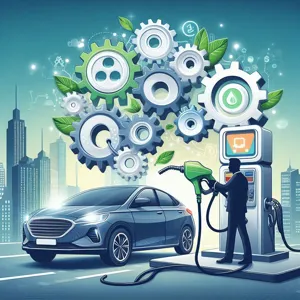In an age where environmental consciousness is more important than ever, making sustainable choices extends beyond our homes and into our vehicles.
Cars are a significant contributor to greenhouse gas emissions and air pollution, but there are numerous ways to reduce your automotive footprint without sacrificing convenience or comfort. Whether you’re a seasoned eco-warrior or just starting to explore green alternatives, the journey to an eco-friendlier vehicle doesn’t have to be overwhelming. In this blog post, we’ll explore ten simple yet impactful strategies to transform your car into a more environmentally friendly mode of transportation. From practical maintenance tips to lifestyle changes that can reduce your carbon emissions, these actionable insights will not only benefit the planet but also enhance your driving experience. Join us as we dive into these eco-friendly practices that can help you drive with a clear conscience and contribute to a healthier planet for generations to come.
1. Understanding the Importance of Eco-Friendly Cars

In today’s world, the urgency of addressing climate change and environmental degradation has never been more pronounced. As individuals and communities strive to reduce their carbon footprints, the role of eco-friendly cars has emerged as a crucial component in this global effort. Understanding the importance of these vehicles goes beyond merely considering fuel efficiency or emissions; it encompasses a commitment to sustainable living and responsible consumption.
Eco-friendly cars, which include hybrids, plug-in hybrids, and fully electric vehicles, offer a cleaner alternative to traditional gasoline-powered vehicles. By utilizing renewable energy sources or reducing reliance on fossil fuels, these cars help decrease greenhouse gas emissions, contributing to cleaner air and a healthier planet. The transportation sector is a significant contributor to pollution, accounting for a large percentage of carbon emissions, so transitioning to greener options can have a profound impact on our environment.
Moreover, embracing eco-friendly vehicles promotes innovation in automotive technology and supports the development of renewable energy infrastructure. As demand for sustainable cars rises, manufacturers are incentivized to invest in research and development, leading to advancements that can further enhance the efficiency and eco-friendliness of future models. This shift not only fosters economic growth but also encourages a cultural change towards prioritizing sustainability in our everyday lives.
Furthermore, eco-friendly cars can lead to significant savings in fuel costs over time. Many electric vehicles come with lower operational costs and government incentives, making them an economical choice in addition to their environmental benefits. By understanding the importance of eco-friendly cars, consumers can make informed decisions that align with their values, ultimately contributing to a more sustainable future for generations to come.
As you embark on the journey of making your car more eco-friendly, take these principles to heart and consider the broader impact of your choices.
2. Regular Maintenance: The Key to Efficiency
Regular maintenance is the cornerstone of ensuring your car operates at peak efficiency, and it plays a crucial role in reducing its environmental impact. Just like a well-tended garden thrives, a car that receives consistent care will not only perform better but also consume less fuel. Start with the basics: routine oil changes using eco-friendly oil, checking and replacing air filters, and ensuring that your tires are properly inflated. Under-inflated tires can significantly decrease gas mileage, leading to increased emissions.
Moreover, don’t overlook the importance of regular inspections of your vehicle’s exhaust system. A damaged exhaust can lead to harmful emissions that contribute to air pollution. Ensure the engine is running smoothly by keeping up with tune-ups, which can enhance fuel efficiency and prolong the life of your vehicle.
In addition to mechanical upkeep, consider the benefits of using high-quality fuel and additives that can help clean your engine and reduce harmful emissions. A clean engine burns fuel more efficiently, translating into lower carbon output and a decreased ecological footprint.
By investing a little time and effort into regular maintenance, you’re not only enhancing the performance and longevity of your car but also taking significant steps toward a greener planet. Each small action compounds, leading to a more sustainable driving experience that benefits both you and the environment. Remember, a well-maintained vehicle is not just good for you; it’s good for the earth!
3. Choosing Eco-Friendly Tires

When it comes to making your car more eco-friendly, the tires you choose play a surprisingly significant role. Eco-friendly tires are designed not only to enhance fuel efficiency but also to reduce the environmental impact of your vehicle. These specialized tires are typically made from sustainable materials and feature advanced tread patterns that optimize performance while minimizing rolling resistance.
Rolling resistance refers to the energy lost as your tires roll across the road. By selecting tires with lower rolling resistance, you can improve your vehicle’s fuel economy, which translates into fewer carbon emissions—an essential factor in combating climate change. Many eco-friendly tire manufacturers also focus on using recycled materials in their products, further reducing the ecological footprint associated with tire production.
In addition to their environmental benefits, eco-friendly tires often promote longer tread life, meaning you won’t need to replace them as frequently. This not only saves you money in the long run but also reduces waste associated with tire disposal. Brands such as Michelin, Goodyear, and Bridgestone have developed lines of eco-conscious tires that cater to various driving styles and conditions, ensuring you don’t have to compromise on performance or safety.
Before making a purchase, be sure to look for certifications and labels that indicate a tire’s eco-friendliness, such as the Green Seal or Eco-Label. By investing in eco-friendly tires, you’re not just making a choice that benefits your own vehicle; you’re also contributing to a sustainable future for our planet. So the next time you’re in the market for new tires, consider how your selection can make a positive impact on the environment.
4. Reducing Weight for Better Fuel Efficiency
Reducing weight is one of the most effective and straightforward methods to enhance your car’s fuel efficiency, and it’s an eco-friendly practice that can lead to significant long-term savings. Every extra pound in your vehicle requires more energy to move, which translates into higher fuel consumption and increased emissions. By shedding unnecessary weight, you can improve not just your car’s performance but also its impact on the environment.
Start by decluttering your vehicle—remove any items that you don’t regularly use. This could be everything from old sports equipment to that collection of empty water bottles that have mysteriously accumulated in your back seat. Each item may seem insignificant on its own, but collectively, they can add up to substantial extra weight.
Consider also the options you have in your car’s design. If your vehicle has a roof rack that you don’t often use, take it off. Roof racks can create additional drag, which can further decrease your fuel efficiency. If you’re packing for a road trip, be mindful of your cargo. Distributing weight evenly and packing lightly will help maintain performance and reduce fuel consumption.
Another consideration is to evaluate your vehicle’s components. If you’re in the market for new tires or parts, look for lightweight alternatives made from advanced materials that can help reduce overall vehicle weight while maintaining safety and performance.
By making these conscious decisions to lighten your load, you’re not only enhancing your car’s fuel efficiency but also contributing to a greener planet. Every small change counts, and with better fuel economy, you’ll find yourself stopping at the pump less often—saving money and reducing your carbon footprint in the process.
5. Opting for Sustainable Fuel Alternatives

As the world becomes increasingly aware of the environmental challenges we face, many car owners are searching for ways to reduce their carbon footprint. One impactful step is opting for sustainable fuel alternatives. Traditional gasoline and diesel contribute significantly to greenhouse gas emissions, but there are several eco-friendlier fuels that can help you drive more responsibly.
Consider switching to biofuels, which are derived from renewable resources such as vegetable oils, animal fats, and even waste products. Biofuels can be used in many conventional engines with little or no modifications, offering a seamless transition while reducing dependency on fossil fuels. Ethanol, for example, is a common biofuel blended with gasoline, and it can significantly lower carbon emissions.
Another great option is electricity. Electric vehicles (EVs) are becoming more popular, and for good reason: they produce zero tailpipe emissions. If you’re not ready to invest in an EV, many cities now offer convenient charging stations, making it easier than ever to transition to electric driving. Additionally, if you have access to renewable energy sources—like solar or wind power—charging your vehicle with clean energy can further amplify your positive impact on the environment.
Hydrogen fuel cells are also gaining traction as a sustainable alternative. These vehicles convert hydrogen and oxygen into electricity, emitting only water vapor as a byproduct. While the infrastructure for hydrogen fueling is not as widespread yet, advancements are being made, and they offer a promising glimpse into the future of green transportation.
Incorporating sustainable fuel alternatives into your driving habits not only benefits the environment but can also result in long-term savings on fuel costs. As technology continues to evolve, staying informed about these options ensures that you can make choices that align with your values while contributing positively to our planet. Embracing sustainable fuels is a significant step towards making your car more eco-friendly, and it’s a choice that benefits both you and the environment.
6. Adopting Eco-Conscious Driving Habits
Adopting eco-conscious driving habits is one of the simplest yet most effective ways to reduce your car’s environmental impact. These habits not only help lower your fuel consumption but also contribute to a healthier planet.
Start by being mindful of your acceleration and braking patterns. Instead of gunning the engine at green lights, accelerate gradually and maintain a steady speed. This smooth driving style can significantly improve your fuel efficiency. Try to anticipate traffic signals and adjust your speed accordingly, allowing your vehicle to coast to a stop rather than slamming on the brakes. This not only saves gas but also reduces wear and tear on your brakes.
Additionally, consider your driving routes. Whenever possible, opt for routes that avoid heavy traffic and stop-and-go situations. Using navigation apps that consider real-time traffic conditions can help you find the most efficient path. Carpooling is another excellent way to reduce your carbon footprint while sharing the ride with others, which can also save you money on fuel and tolls.
Another habit to adopt is to limit your use of air conditioning unless absolutely necessary. Air conditioning can increase fuel consumption, especially at lower speeds. Instead, try to roll down the windows or use the vehicle’s ventilation system. If you do need to use the AC, consider using it sparingly and at lower settings to minimize its impact.
Lastly, keep your vehicle well-maintained. Regular oil changes, tire inflation checks, and engine tune-ups can enhance your car’s performance and fuel efficiency. An eco-friendly vehicle is a well-cared-for vehicle, and small adjustments to your driving habits can lead to significant reductions in emissions over time. By incorporating these eco-conscious practices into your daily routine, you’ll not only contribute to a greener planet but also enjoy the benefits of improved gas mileage and reduced wear on your vehicle.
7. Utilizing Public Transportation or Carpooling

Utilizing public transportation or carpooling can significantly reduce your carbon footprint while also saving you money on gas and maintenance costs. Imagine the impact if more drivers opted for these alternatives instead of taking solo trips in their vehicles.
Public transportation systems, such as buses, trains, and subways, are designed to carry multiple passengers at once, meaning fewer cars on the road and less congestion. By hopping on a bus or train, you’re not only contributing to a decrease in greenhouse gas emissions but also supporting a more sustainable urban infrastructure. Many cities are investing in greener transit options, with electric or hybrid buses becoming more common. This means that your choice to use public transport can have a direct positive impact on air quality, helping to create cleaner, healthier communities.
Carpooling is another excellent alternative that promotes collaboration among friends, coworkers, and neighbors. By sharing rides, you can significantly cut down on the number of cars on the road, which not only reduces pollution but also lessens wear and tear on your vehicle. Plus, carpooling fosters a sense of community as you bond with others during your commute. Many ride-sharing apps can facilitate this process, connecting you with others traveling in the same direction.
Both public transportation and carpooling can also lead to a more enjoyable travel experience. You can relax, catch up on some reading, or even work while someone else is driving. As an added bonus, these options often come with reduced stress and less hassle related to traffic and parking.
Incorporating public transport or carpooling into your routine is a simple yet effective way to make your car usage more eco-friendly and contribute to a sustainable future. Embrace the change, and you’ll find that the journey can be just as rewarding as the destination.
8. Embracing Electric or Hybrid Vehicles
Embracing Electric or Hybrid Vehicles
One of the most impactful choices you can make for your carbon footprint is transitioning to an electric or hybrid vehicle. These innovative options represent the forefront of eco-friendly transportation, combining cutting-edge technology with sustainability. Electric vehicles (EVs) run entirely on electricity, eliminating tailpipe emissions and significantly reducing air pollution. On the other hand, hybrid vehicles combine a traditional internal combustion engine with an electric motor, providing greater fuel efficiency and lower emissions than conventional cars.
The benefits of switching to an EV or hybrid are manifold. Not only do these vehicles contribute to a cleaner environment, but they also offer significant cost savings over time. With fewer moving parts, electric engines require less maintenance than their gasoline counterparts, and charging them can often be cheaper than filling up at the pump—especially if you take advantage of off-peak charging rates or install solar panels at home.
Moreover, governments around the world are incentivizing the adoption of electric and hybrid vehicles through tax credits, rebates, and access to carpool lanes, making the transition even more appealing. As charging infrastructure continues to expand, the convenience of owning an EV becomes increasingly accessible.
Beyond personal benefits, choosing electric or hybrid vehicles sends a powerful message about your commitment to sustainability. By opting for greener transportation, you’re not just reducing your own emissions; you’re also supporting the automotive industry’s shift toward environmentally friendly practices. It’s a step toward a more sustainable future, where cleaner air and reduced reliance on fossil fuels are within reach. So, if you’re looking to make a significant change in your eco-footprint, consider embracing the electric or hybrid revolution—your planet will thank you!
9. Implementing Eco-Friendly Accessories
Implementing eco-friendly accessories is a fantastic way to enhance your vehicle’s sustainability without compromising on style or functionality. From innovative gadgets to simple alterations, these accessories not only help reduce your carbon footprint but also contribute to a more efficient and enjoyable driving experience.
Start with solar-powered chargers; these handy devices harness the sun’s energy to keep your electronics charged without drawing power from your car. Imagine being able to power your smartphone or GPS while reducing reliance on fossil fuels—it’s a win-win!
Next, consider investing in eco-friendly floor mats made from recycled materials. These mats not only reduce waste but also offer durability and easy maintenance, ensuring your car’s interior remains clean and green. Additionally, look for seat covers that are made from organic fabrics or recycled materials. They provide comfort while supporting sustainable manufacturing practices.
Another essential accessory to consider is a tire pressure monitoring system. Properly inflated tires improve fuel efficiency, meaning you’ll use less gas and reduce emissions. By integrating this technology, you’re not only enhancing safety but also promoting a more eco-conscious way of driving.
Lastly, explore eco-friendly air fresheners made from natural ingredients. These alternatives help eliminate odors without releasing harmful chemicals into your car’s atmosphere, creating a healthier environment for you and your passengers.
By adopting these eco-friendly accessories, you’re taking meaningful steps toward a greener lifestyle, proving that driving sustainably can be both stylish and practical. Plus, each small change adds up, allowing you to enjoy the road while being a responsible steward of our planet.
10. Creating a Green Driving Plan
Creating a Green Driving Plan is a proactive approach to reducing your vehicle’s environmental impact while enhancing fuel efficiency and sustainability. It starts with a thorough assessment of your driving habits, allowing you to identify areas for improvement. Consider mapping out your routes ahead of time to avoid unnecessary detours and traffic congestion, which not only saves fuel but also reduces emissions.
Incorporate carpooling into your routine whenever possible. By sharing rides with friends or coworkers, you can significantly decrease the number of vehicles on the road, leading to lower carbon footprints. Additionally, explore flexible work hours or remote work options that can help you avoid peak traffic times altogether.
Regular vehicle maintenance is another critical component of your driving plan. Ensure that your tires are properly inflated, your oil is changed regularly, and your engine is tuned to optimal performance. A well-maintained car runs more efficiently, using less fuel and producing fewer emissions.
Lastly, embrace eco-friendly driving techniques. Smooth acceleration and deceleration, maintaining a steady speed, and using cruise control on highways can improve your fuel economy. By adopting these mindful practices and incorporating them into your daily driving routine, you not only contribute to a healthier planet but can also enjoy the benefits of cost savings at the pump. A well-crafted Green Driving Plan not only makes you a more responsible driver but also empowers you to make a positive impact on the environment.
11. Educating Yourself on Environmental Impact
### 11. Educating Yourself on Environmental Impact
Understanding the environmental impact of your vehicle is a crucial step toward making eco-friendly choices. Knowledge is power, and by educating yourself about how cars affect our planet, you can adopt practices that minimize your carbon footprint. Start by researching the various emissions produced by different types of vehicles, including the greenhouse gases that contribute to climate change.
Dive into the nuances of fuel efficiency and how it varies across makes and models. For instance, many drivers may not realize that even minor adjustments in driving habits—such as avoiding rapid acceleration or maintaining steady speeds—can lead to significant reductions in fuel consumption. Explore the benefits of hybrid and electric vehicles, which can drastically cut down on emissions compared to traditional gasoline-powered cars.
Additionally, familiarize yourself with the principles of eco-driving, a set of techniques aimed at optimizing fuel use and reducing waste. This includes understanding the importance of regular vehicle maintenance, which not only prolongs the life of your car but also ensures it’s operating at peak efficiency.
Consider joining local environmental groups or online forums to stay updated on the latest sustainable practices and technologies in the automotive industry. Awareness of government incentives for eco-friendly vehicles can also guide your purchasing decisions.
The more you know about the environmental implications of your driving habits and vehicle choices, the better equipped you will be to make informed decisions that contribute to a healthier planet. As you become an advocate for sustainability in your automotive choices, you’ll inspire others to do the same, creating a ripple effect that promotes a greener future for all.
12. Recycling and Proper Disposal of Car Parts
When it comes to making your car more eco-friendly, recycling and the proper disposal of car parts is a crucial step that often goes overlooked. Automobiles are complex machines made up of numerous components, and many of these parts can be recycled or reused, significantly reducing their environmental impact. Instead of simply discarding old parts or allowing them to languish in landfills, consider the eco-conscious alternatives that are available to you.
Start by identifying which parts can be recycled. Metal components, such as the body panels, engine parts, and exhaust systems, are highly recyclable and can be melted down and remade into new products. Meanwhile, rubber tires can be repurposed for various uses, from playground surfaces to asphalt mixtures. Even glass from windows and windshields can be recycled into new glass products, minimizing waste and conserving resources.
Beyond recycling, it’s equally important to ensure that hazardous materials—like batteries, oil, and brake fluids—are disposed of properly. These substances can pose significant risks to the environment if not handled correctly. Many auto shops and recycling centers offer safe disposal services for these items, ensuring they are processed in an environmentally responsible manner.
Additionally, consider sourcing used or refurbished car parts when making repairs or upgrades to your vehicle. This not only extends the life of existing materials but also often comes at a lower cost compared to brand new parts. By opting for secondhand components, you’re contributing to a circular economy that prioritizes sustainability.
By prioritizing the recycling and proper disposal of car parts, you not only help reduce waste and pollution but also encourage a more sustainable automotive industry. This simple yet impactful action can significantly lessen your car’s ecological footprint, making it a greener choice for both you and the planet.
13. Supporting Sustainable Automotive Brands
When it comes to making your car more eco-friendly, one of the most impactful decisions you can make is to support sustainable automotive brands. The automotive industry is undergoing a significant transformation, with many companies prioritizing sustainability in their manufacturing processes and product offerings. By choosing to invest in brands that champion eco-friendly practices, you not only contribute to a greener planet but also encourage other manufacturers to follow suit.
Sustainable automotive brands are dedicated to reducing their environmental footprint through various innovative approaches. For instance, many of these companies utilize recycled materials in their vehicle production, minimizing waste and conserving natural resources. They often adopt energy-efficient manufacturing processes, reducing greenhouse gas emissions and promoting cleaner air.
Moreover, several forward-thinking brands are leading the charge in electric and hybrid vehicle technology, providing consumers with choices that produce fewer emissions than traditional gasoline-powered cars. These vehicles not only help reduce reliance on fossil fuels but also often come with lower operating costs and tax incentives for eco-conscious buyers.
When you choose to support these brands, you send a powerful message that environmentally responsible practices matter to consumers. By aligning your purchasing decisions with your values, you can play a vital role in shaping a more sustainable future for the automotive industry. Look for certifications, such as LEED (Leadership in Energy and Environmental Design) for manufacturing facilities or vehicles that meet strict emissions standards, to ensure that your choice is indeed making a positive impact.
In addition to purchasing a vehicle from a sustainable brand, consider supporting local companies that prioritize eco-friendliness in their operations. From sourcing materials responsibly to offering car maintenance services with a focus on sustainability, these businesses contribute to a more circular economy and help foster a community of environmentally conscious consumers. By taking this step, you not only make a greener choice for yourself but also contribute to a larger movement towards sustainable automotive practices.
14. Encouraging Eco-Friendly Practices in Your Community
Encouraging eco-friendly practices in your community is a powerful way to amplify your commitment to sustainability beyond your own vehicle. When you take the initiative to inspire those around you, you create a ripple effect that benefits the entire environment. Start by organizing or participating in local clean-up events, where residents come together to collect litter from parks, beaches, or roadside areas. Not only does this beautify your surroundings, but it also fosters a sense of community spirit and collective responsibility for the environment.
Consider hosting workshops or informational sessions on car maintenance tips that promote eco-friendliness, such as proper tire inflation and regular oil changes. These simple practices can enhance fuel efficiency and lower emissions, yet many people may not realize their importance. Share resources on public transportation options, carpooling initiatives, or even bike-sharing programs to illustrate that alternatives to solo driving are not only available but beneficial for everyone involved.
Engage with local businesses to encourage them to adopt greener practices as well. Start a dialogue about the advantages of offering incentives for customers who arrive on foot, by bike, or in a carpool. These small changes can help shift community behavior towards more sustainable transport methods and reduce the overall carbon footprint.
Additionally, use social media platforms to spread awareness about eco-friendly driving habits and community events. Highlight success stories, share tips, and create a platform for discussions about sustainability. By promoting an eco-conscious mindset within your community, you not only contribute to a healthier environment but also foster a culture of collaboration that can lead to lasting change. Together, you can drive the movement toward a more sustainable future, one eco-friendly practice at a time.
15. Conclusion: Taking Action for a Greener Future
In conclusion, taking action for a greener future begins with the choices we make today—especially when it comes to how we use and maintain our vehicles. The journey towards eco-friendliness doesn’t require a complete overhaul of your lifestyle; rather, it involves small, intentional steps that collectively contribute to a significant impact. By implementing the tips outlined in this blog, you can reduce your carbon footprint while enjoying the many benefits of an eco-friendly car.
From routine maintenance practices that enhance fuel efficiency to adopting sustainable driving habits, each action is a step toward a more sustainable world. Consider the possibilities of carpooling, utilizing public transportation, or even exploring electric and hybrid vehicles as viable alternatives. The ripple effect of your choices can inspire those around you to follow suit, creating a community of environmentally conscious drivers.
As we face the pressing challenges of climate change and environmental degradation, our responsibility as consumers and car owners becomes clearer. Every effort counts, whether it’s reducing unnecessary emissions, choosing eco-friendly products, or simply being more mindful of our driving habits. A greener future is within our reach, and it starts with each of us making a commitment to change. So, let’s buckle up for the ride ahead and take meaningful steps towards a more sustainable automotive lifestyle—because every mile driven with intention brings us closer to a healthier planet.
In conclusion, making your car more eco-friendly doesn’t have to be a daunting task; it can be an enjoyable journey toward sustainability. By implementing these 10 simple strategies—from regular maintenance and efficient driving habits to choosing eco-conscious products—you can significantly reduce your carbon footprint while enjoying the many benefits of a greener vehicle. Each small change contributes to a larger impact, helping to preserve our planet for future generations. We encourage you to start with one or two tips that resonate with you and gradually build from there. Share your eco-friendly journey with us, and let’s drive towards a more sustainable future together! Safe travels and happy eco-driving!




























